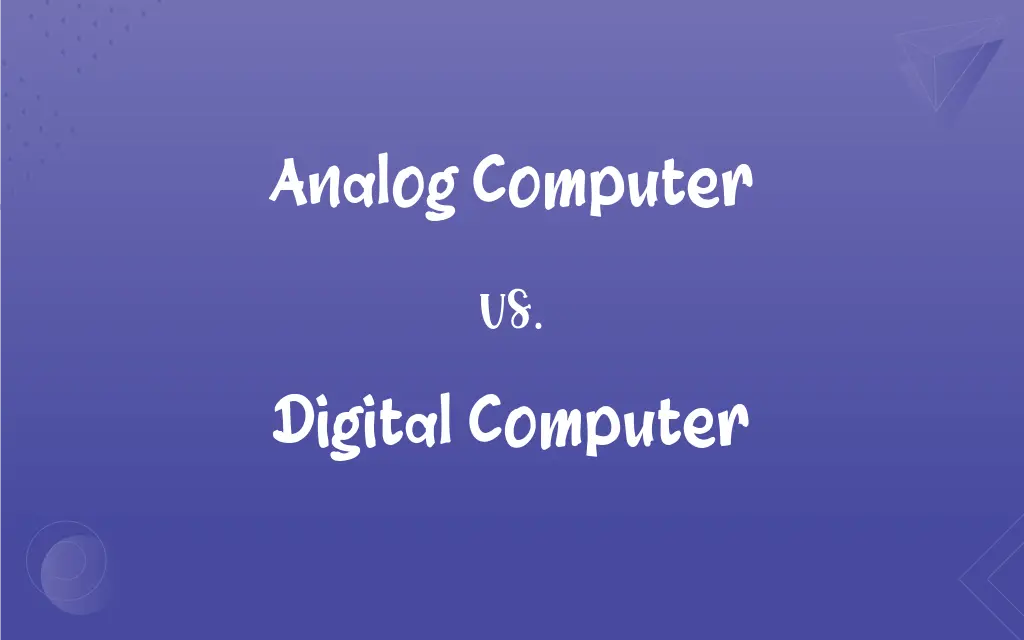Analog Computer vs. Digital Computer: What's the Difference?
Edited by Janet White || By Harlon Moss || Updated on October 6, 2023
Analog computers perform calculations using continuously variable physical quantities, while digital computers execute calculations using discrete data represented in binary.

Key Differences
Analog computers embody a technology that employs continuous physical phenomena, such as electrical, mechanical, or hydraulic quantities, to solve problems. Digital computers leverage binary code, utilizing discrete numerical values, specifically 0s and 1s, to perform computations and process information. Both computers exhibit their own unique set of capabilities and restrictions, dictated significantly by their underlying computational mechanisms.
Analog computers offer the advantage of being able to solve complex equations at high speeds by directly manipulating continuous data. Conversely, digital computers may take longer to solve certain complex mathematical equations but excel in handling and processing vast amounts of data efficiently and accurately. Both types of computers find their respective domains where they provide the most utility and efficacy.
Historically, analog computers have been used for specific applications such as solving differential equations and simulation purposes. Digital computers, owing to their ability to store, retrieve, and process large datasets, have become omnipresent in diverse areas like business, education, and research. Both have played pivotal roles in technological evolution, albeit in different eras and applications.
In the context of accuracy and precision in computations, digital computers generally exhibit superiority due to their discrete data handling and reduced susceptibility to signal degradation. Analog computers, while capable of rapid computations, can be more prone to inaccuracies emanating from variations or disturbances in physical signals. Each type of computer, thus, has scenarios where it may be deemed more appropriate based on the precision and nature of computations required.
The role of analog computers has diminished with technological advancements, particularly due to the digital revolution, which has overwhelmingly favored the adoption of digital computers. Despite this, analog computers offer valuable insights into historical computational methodologies and maintain relevance in specific scientific and educational contexts. Digital computers continue to evolve and permeate every aspect of modern life, delineating a stark contrast between the historical significance and future potential of both technologies.
ADVERTISEMENT
Comparison Chart
Data Representation
Represents data in a continuous form
Represents data in a discrete binary form
Processing Speed
Can be extremely fast for certain specific calculations
Handles a broad range of computations with high efficiency
Accuracy and Precision
May be subject to inaccuracies from signal disturbances
Typically more accurate due to binary data handling
Storage Capacity
Generally lacks extensive data storage capabilities
Capable of storing and retrieving large amounts of data
Application Relevance
Mostly found in specialized and historical contexts
Pervasive in numerous modern applications
ADVERTISEMENT
Analog Computer and Digital Computer Definitions
Analog Computer
An analog computer uses continuous physical quantities to perform computations.
The scientist used an analog computer to solve differential equations quickly.
Digital Computer
Digital computers use discrete values for computation, ensuring a high level of accuracy.
Scientists prefer digital computers for long-term, detailed simulations due to their accuracy.
Analog Computer
Analog computers directly manipulate input to generate output without digitization.
The analog computer processed input voltages to yield an immediate, continuous output.
Digital Computer
A digital computer performs computations using binary code, representing data as 0s and 1s.
The digital computer processed vast amounts of data with precision, using its binary coding system.
Analog Computer
Analog computers have historically been utilized for specialized scientific computations.
In the past, an analog computer was crucial for performing certain navigational calculations.
Digital Computer
Digital computers allow for software utilization, enabling diverse operations and applications.
Graphic designers utilize specialized software on digital computers to create their artworks.
Analog Computer
Analog computers can compute several calculations simultaneously by manipulating continuous signals.
The analog computer was able to calculate numerous related variables in parallel, aiding the scientific simulation.
Digital Computer
Digital computers can be interconnected, forming networks for communication and data sharing.
Through the internet, digital computers globally share and receive information seamlessly.
Analog Computer
Analog computers typically employ electrical, hydraulic, or mechanical systems for calculations.
Engineers once utilized analog computers for real-time simulations in hydraulic systems.
Digital Computer
Digital computers are capable of storing and retrieving extensive data for various applications.
Using the digital computer, the researcher could store and analyze large datasets efficiently.
FAQs
How do analog computers represent data?
Analog computers represent data through continuous signals like electrical voltage or fluid pressure.
Can digital computers perform various tasks simultaneously?
Yes, digital computers can multitask, handling multiple operations at once thanks to modern processors.
How does the internet work on digital computers?
Digital computers communicate via the internet using protocols like TCP/IP to exchange binary data.
What is the primary storage medium of digital computers?
Digital computers use hard drives, SSDs, and RAM for data storage and retrieval.
What is an analog computer?
An analog computer performs calculations using continuous physical phenomena.
How does a digital computer work?
A digital computer processes information using binary data, represented as 0s and 1s.
Can digital computers be used for creating animations?
Absolutely, digital computers enable the creation of animations using specialized software and graphical data processing.
Is programming languages applicable to digital computers?
Yes, programming languages enable digital computers to process data, manage operations, and run applications.
Do digital computers need electricity?
Yes, digital computers require electricity to operate the processor, storage, and other components.
What were analog computers primarily used for in the past?
Analog computers were used for specific calculations, like solving differential equations and simulations, particularly in scientific and navigational contexts.
Are digital computers versatile in terms of application and utility?
Yes, digital computers are highly versatile, used in various fields like science, business, design, and more, due to their programmability and extensive data handling capabilities.
Are analog computers still in use today?
Yes, analog computers are used in niche applications, such as certain engineering simulations.
Can analog computers run software programs?
No, analog computers don’t run software in the same way digital computers do, but operate using physical configurations.
Why are analog computers not prevalent in modern computing?
Analog computers are limited in storage, precision, and data handling compared to digital counterparts.
How are errors corrected in digital computers?
Digital computers utilize error-checking protocols and algorithms to identify and correct data transmission and processing errors.
What are examples of physical phenomena used in analog computers?
Examples include electrical voltage, mechanical motion, and hydraulic pressure.
How do digital computers manage graphical data?
Digital computers manage graphics using video cards and software, rendering visuals in a digital format.
Are analog computers typically more accurate than digital computers?
Not generally; analog computers can be susceptible to inaccuracies from physical disturbances, whereas digital computers ensure high accuracy through binary computation.
Can analog computers be used for multimedia applications?
Analog computers are not ideal for multimedia due to their lack of data storage and discrete data handling capabilities.
Is there a size limitation to analog computers?
Analog computers can vary in size, but practical implementations are often limited by physical components and scalability issues.
About Author
Written by
Harlon MossHarlon is a seasoned quality moderator and accomplished content writer for Difference Wiki. An alumnus of the prestigious University of California, he earned his degree in Computer Science. Leveraging his academic background, Harlon brings a meticulous and informed perspective to his work, ensuring content accuracy and excellence.
Edited by
Janet WhiteJanet White has been an esteemed writer and blogger for Difference Wiki. Holding a Master's degree in Science and Medical Journalism from the prestigious Boston University, she has consistently demonstrated her expertise and passion for her field. When she's not immersed in her work, Janet relishes her time exercising, delving into a good book, and cherishing moments with friends and family.































































